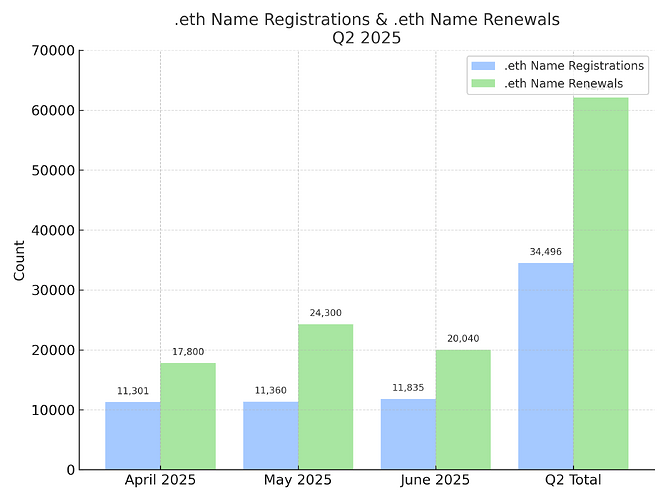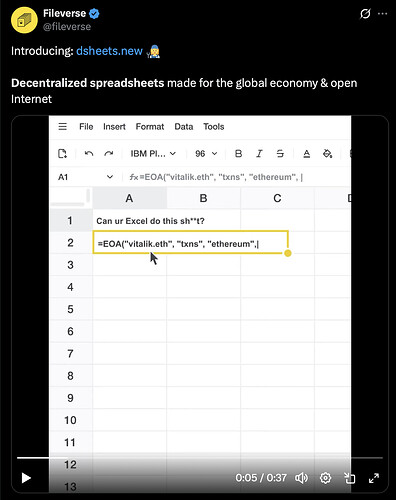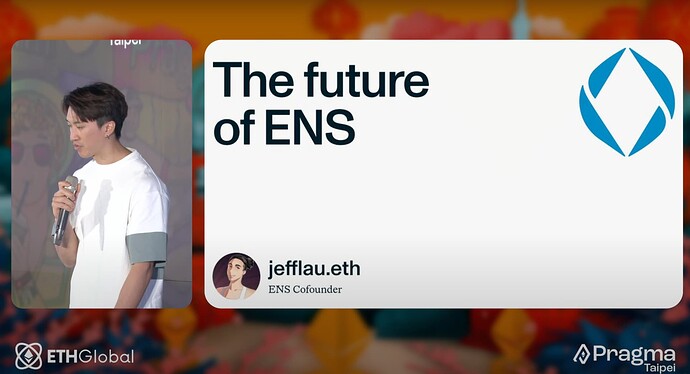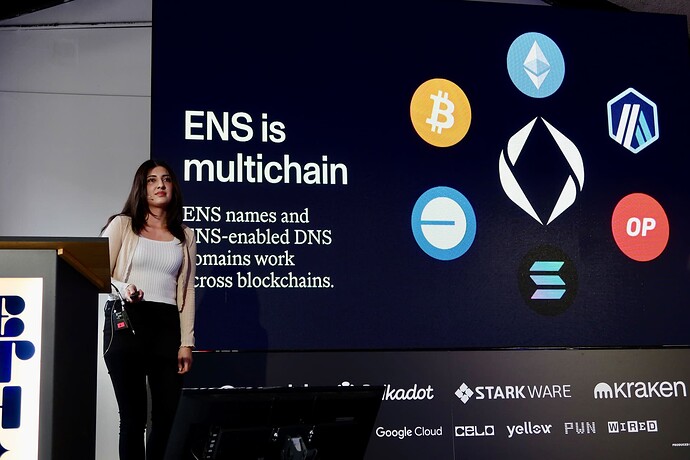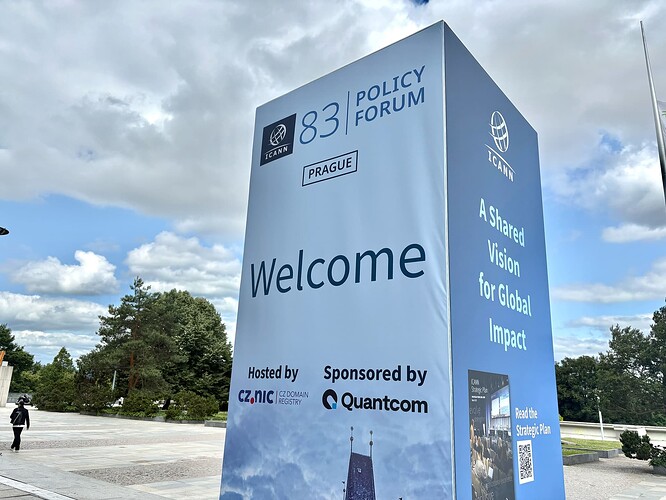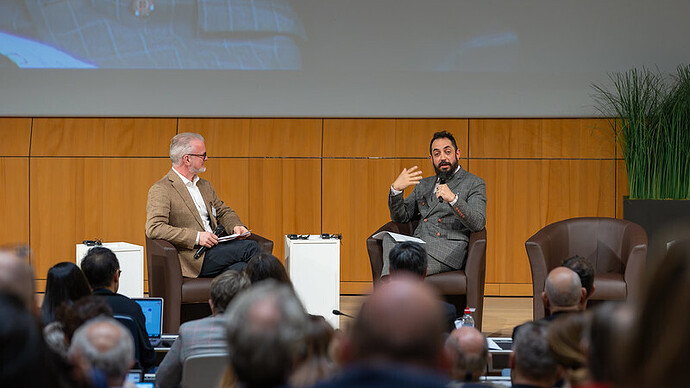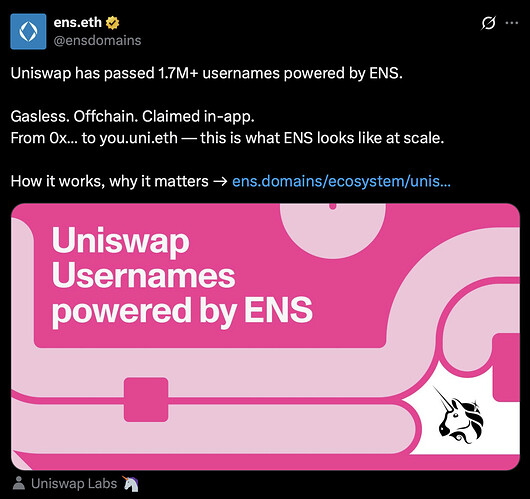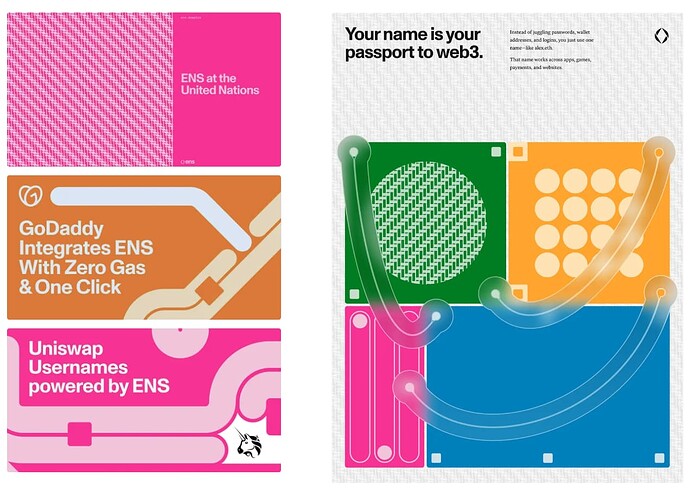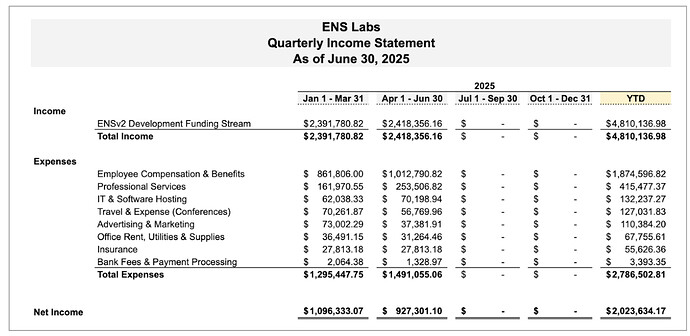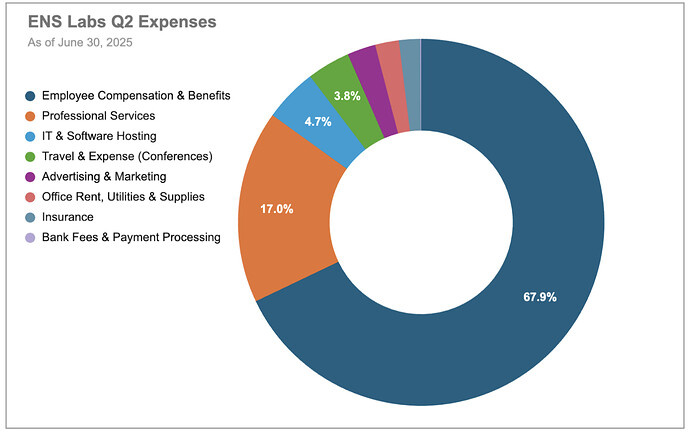ENS Labs Quarterly Report - Q2 2025
Abstract
Q2 2025 marked a steady shift from planning to execution. With the core ENSv2 contracts now complete and key infrastructure like the Universal Resolver and ENSv2 SDK shipped, the foundation for Namechain is solidifying. Work is now underway to prepare for audits, finalize cross-chain functionality, and build developer tools that make the transition from ENSv1 to ENSv2 seamless.
In parallel, the Product and Design teams kicked off two new apps that will define the ENSv2 user experience; these will be launched with the mainnet release of ENSv2. In Q2, we also built the ENSv2 Hub, the new L2 Primary Names app, and our first fully wireframed Manager interface, signaling clear movement from concept to implementation.
Beyond the code, we are continuing to deepen our presence in the ecosystem—from our integration with dSheets, to participation at ETHGlobal Taipei, ETHPrague, and ICANN83. Community engagement, education, and real-world use cases remain a key focus as we lay the groundwork for ENSv2 adoption later this year.
Q3 will be about tightening the path to launch: finalizing audits, preparing migration tools, and expanding integration support. The work continues, and we are excited heading into H2 of 2025 with so much momentum.
Team
As of Q2 end, the ENS Labs team sits at 31 full-time hires. We made critical hires this quarter across DevRel, Product, and Engineering. We are continuously hiring for the team, and if you are excited about ENS and the work that we are doing here at Labs, please consider joining us!
Growth, Ecosystem & Community
While engineering efforts are fully-focused on building ENSv2, our growth, ecosystem, and community efforts were to 1) create more compelling visual tutorial content to help solve existing user pain-points; 2) create integration case studies to support our efforts to expand ENS integrations with fintech and web3 apps; 3) create a new ENSv2 hub to help answer users questions around migration to Namechain and build excitement for an all new ENS app experiences; 4) double-down on our ICANN strategy ahead of the 2026 gTLD round.
Growth Indicators
In Q2 2025, renewals overtook registrations as the primary source of revenue (ETH), which remains stable over Q1 2025.
(Source: https://dune.com/ethereumnameservice/ens)
Subnames continue to be a key driver of ENS name proliferation across the ecosystem, and we’re actively working to onboard additional subname adoption partners in the coming quarters.
Looking ahead, the proposed new .eth registrar controller introduces support for a referrer field on registration and renewal transactions. (More on this under “Protocol Updates”). This lays the groundwork for potential referral programs and may influence registration and renewal activity in the quarters to come. We’ll be monitoring closely and welcome any new integration partners to take advantage of this feature.
Events & Community Highlight
ENS integrated with Fileverse’s new product, dSheets—a decentralized spreadsheet built for the open internet. ENS names can now be used to read, write, and collaborate on onchain data directly from a spreadsheet interface. From querying smart contracts to pulling transaction history for names like vitalik.eth, dSheets brings onchain data to life using familiar spreadsheet functions—all while respecting privacy, permissioning, and user ownership.
On the IRL events front, jefflau.eth took the stage at ETHGlobal Taipei / Pragma Taipei to share the future vision for ENS in a 20- min talk titled “The Future of ENS- What Namechain Unlocks”. At the subsequent ETHGlobal Taipei Hackathon, 11.5% of all 244 submitted hackathon projects integrated ENS. In May, mely.eth attended ETHPrague and gave a talk titled “From Domains to Usernames,” exploring how ENS is evolving as a user identity layer.
Looking ahead to Q3, we hope to continue to expand our IRL presence—attending EthCC, EthGlobal New Delhi, EthAccura, and a few others. We are also cooking up plans for DevConnect in Buenos Aries at the end of this year. There’ll be more to come, and we hope to see you all IRL in the meantime!
ENS at ICANN in Prague
ENS Labs had the chance to attend the ICANN Policy Forum in Prague this June. These meetings bring together registries, registrars, Registry Service Providers(“RSP”), and ICANN groups like the Governmental Advisory Committee (“GAC”) to talk policy. Throughout the week, the team held productive conversations with dozens of current and prospective partners across the domain name ecosystem, including registries, registrars, policy organizations, and root server operators.
On a macro note, market activity is clearly picking up with the next round of gTLDs just around the corner in April 2026. The US caused a bit of a stir by urging caution on new gTLDs, pointing to the rise in global phishing. Overall sentiment toward crypto remains skeptical, but many were optimistic and saw it as a path to business growth. Those familiar with ENS respected our approach to engaging with ICANN, but the idea of full self-sovereignty is still a tough sell for some, especially those coming from a traditional IP mindset.
That being said, our consistent adherence to DNS norms and ICANN policies, including early and proactive engagement on name collision issues, has built meaningful credibility within the community. We are particularly encouraged by the forthcoming new gTLD program, which represents a unique opportunity to embrace the traditional DNS within the context. We believe that, with the right alignment, this initiative will lay the foundation for a single, unified internet.
ENS Labs remains committed to engaging constructively within the ICANN ecosystem. We look forward to continued collaboration and helping to shape a global naming infrastructure that is inclusive, resilient, and onchain. This is a multi-year effort that does not stop in April 2026, and we will continue to work with registries, registrars, and RSPs to find ways to integrate with ENS into the full DNS stack.
ENS at the United Nations
In April, Alex Urbelis spoke at the 25th Anniversary of the Uniform Domain-Name Dispute-Resolution Policy (UDRP) hosted by World Intellectual Property Organization (WIPO) in Geneva, Switzerland. As we prepare to apply for several strings in ICANN’s upcoming new gTLD program, ENS Labs is ready to fully comply with UDRP in all of its ICANN-authorized TLDs. However, we also believe that future rights protection mechanisms in Web3 should reflect the people, processes, and philosophy of Web3 systems. That is, rights protection mechanisms should evolve to be onchain, community-driven, and openly discussed within organizations like the ENS DAO. For a deeper dive on the topic, check out the blog post authored by Alex.
Social
Our social strategy this quarter included daily tutorials to help existing users understand all the features of ENS, as well as to motivate new users to register a name for the first time. In reviewing customer support tickets over the last 6 months, we noticed a significant trend: nearly half of all tickets were from users wanting “guidance”, “how-to”, or “general” guides on certain actions—like registering a name, sending a name, changing owners, importing DNS, and so on. For this reason, we emphasized posts that visually show how to do things in the ENS app, as well as use ENS in other apps like PayPal or Venmo.
So far, data on X supports that visual tutorials are having a positive impact:
Video views: 26.1K—up 67%
Media views: 32.3K—up 61%
Reposts: 2.3K—up 3%
Bookmarks: 677—up 63%
Shares: 77—up 54%
Our videos are getting significantly more attention, helping audiences who prefer to learn through visual aids. People are sharing our content more, trying to help their own audiences, and interestingly, people are bookmarking our content more as well, presumably to reference it in the future when they want to take a particular ENS action. All of this points to signs that audience engagement with our media content is up, meaning we’re reaching a more engaged audience with higher quality content.
Content
This quarter, we updated the Ecosystem page on ens.domains to help surface real integration examples with some of our biggest partners. While the page previously showcased partner logos, it lacked direct links to case studies that walk through specific implementations. We recognized the need to make these examples more discoverable, especially for teams exploring how to integrate ENS based on their use case.
To kick things off, we published our first official case study with Uniswap—a strong example of what ENS can enable at scale. In the coming weeks, we’ll be adding several more case studies to the page, each highlighting different categories of integration: search/identity, domain registrars, payments, and crypto wallets. This will give both partners and the broader ecosystem clearer reference points for how ENS is being used in the wild. We plan to release more case studies in the weeks to come, and hope that these case studies can showcase the full power of ENS names across our integration partners.
ENSv2 Hub
We also announced the updated ENSv2 Hub on ens.domains, the first major step in surfacing what’s coming in ENSv2 beyond Namechain. Until now, most of the conversation around v2 has been limited or abstract. This hub marks the beginning of a more public, concrete narrative around the protocol’s next evolution.
The ENSv2 Hub is designed to be a living resource. It outlines what ENSv2 is, why it matters, and what’s changing—including a high-level roadmap, early product previews, and technical context for developers and users. It’s also the first time we’ve publicly teased the upcoming manager and portal apps, giving the community a first glimpse of the new interfaces in development.
As more of the product moves from design into build, the hub will continue to grow and serve as a central, up-to-date destination for everything related to ENSv2. This is a foundational moment to reintroduce the broader goals of v2, and the hub helps position us to share updates more transparently as we build in the open.
Press
In Q2 2025, ENS was featured in 6 pieces of earned coverage with an estimated 54.9K views. Highlights include:
- Nick guest featured on The Epicenter Podcast
- Nick’s commentary on the ETH Pectra upgrade was included in The Defiant
- Alex Urbelis had interviews with Fortune and CoinDesk on the Virgil Griffith release
- James Beck’s interview on L2s was featured in Cointelegraph and he guest featured on an X spaces with WenALTSeason (Pt 2)
- Makoto’s interview on Namechain was featured in Blockmedia
As always, we are open to feedback on what other educational topics you’d like to see from us on anything ENS-related!
Product & Design Updates
Q2 began with a weeklong product and engineering offsite in Taiwan, where the team kicked off work on two new apps. Design shared research on audience needs and what was achievable by year-end, aligning with Product and Engineering to define a shared roadmap and timelines.
For the Manager app, we restructured navigation around user tasks (e.g., “Edit Profile” before “Choose Name”), creating a more intuitive experience aligned with user mental models. For the Portal app, we trimmed scope to focus on core functionality that complements the Manager.
Working closely with Engineering, we defined the Hidden Contract Account (HCA) strategy for seamless cross-chain interactions and mapped out how HCAs will function in-app. With IAs (Information Architecture) and HCAs in place, we built full wireframes for the Manager and made strong progress on key Portal flows.
We also launched the ENSv2 Hub (mentioned in Content section), completed the new L2 Primary Names app (releasing imminently—more on this in the Protocol section), and welcomed a dedicated brand designer who has been elevating our visual identity across all assets, including animations, UI patterns, and branding visible in the new Hub.
In Q2, we continued exploring the ENS rebrand, focusing on creating a more robust and flexible visual system that can adapt to different audiences and contexts. This work lays the groundwork for future brand expressions (especially in physical spaces) and opens the door for more creative executions of how to extend the ENS Brand moving forward. To celebrate ENS’s 8th birthday, we released a 3D animation that pushed the boundaries of our current branding system and offered a glimpse into what more immersive brand work could look like. Watch it here.
Engineering Updates- Web
Q2 saw substantial progress on both ENSv1 and ENSv2, with new infrastructure, tooling, and frontend improvements shipping across the board.
On the ENSv2 side, we’ve implemented an uptime monitor for CCIP-Read gateways, including automated email alerts—critical infrastructure, as these gateways will be core to future ENS resolution. Work is also well underway on the next version of ENSjs, our developer library for interacting with the protocol, as well as early-stage prototyping and finalizing of tech stack decisions for upcoming apps.
Behind the scenes, we’ve completed a local devnet environment with deployed Namechain contracts and mocked cross-chain interactions, giving us a strong foundation for testing. We also now publish a Docker image of Namechain on every main branch merge, making it easier for external developers to spin up ENSv2 contracts locally.
On the ENSv1 side, we’ve been working on a standalone app for managing L2 primary names, expected to launch next quarter. Frontend work included cleaned-up animations on ens.domains, and better automated testing support for Safe wallets. We also extracted our test environment into a standalone project, helping streamline usage across internal apps and making it easier for external contributors to build against. Our test infra has now moved from relying on The Graph to using Namehash Labs’ ENS Node, which lays the groundwork for migrating the live Manager app (and eventually the new v2 apps) to this more performant backend.
We also migrated RPCs used in our apps from Infura to dRPC, for improved reliability and performance.
A number of frontend bugs were also addressed this quarter, including:
- The “Extend” modal not loading properly when logged out
- Cross-device login issues with Para’s “Connect” button on mobile
- A bug where entering a name in the search box would append an extra “.eth”
- Fixes for toast interactivity and styling, dropdowns, and injected wallet support in Safari
- Several Safe Wallet issues related to gas estimation and transaction labeling
- Moonpay credit card modals not loading correctly
- A glitch with the premium graph UI on hover
Finally, we made a few important security upgrades, including improvements to our automated CSP monitoring and enhanced DNS configuration across ENS-owned domains to strengthen email security.
Engineering Updates- Protocol
ENSv2
All core ENSv2 contracts are now complete! These new contracts would cover everything needed to support standalone deployments on both L1 and L2. There is still some remaining work we will focus on completing in the coming weeks, including real cross-chain messaging for Linea (currently mocked in dev environments) and migration contracts to facilitate the transition from V1 to V2. As we head into Q3, we will also look to secure a reputable auditor to begin the audit process so that the full audit may be completed by year-end.
Additionally: the ENSv2 SDK is out! The devnet script will allow for developers to run L1 and L2 testnets with a single command, providing a stable development and testing environment for those who wish to build on ENSv2.
ENS Core Development
A new version of the Universal Resolver was released this quarter, with a stable interface guaranteed across the V1 to V2 transition. This means developers and integrators can safely update to the latest version now, and once V2 launches, migrating will be as simple as updating the contract address. See the implementation contract here and the proxy here.
We also put up an executable proposal this quarter that will enable a new .eth register controller. This will allow for a few key features, namely:
- Setting a default primary name across all chains at registration time (L2 Primary Name support). ENS primary names are currently only officially supported on Ethereum Mainnet. With this launch, primary names will be supported on multiple L2s, which would make it possible for developers and users to have an end-to-end experience with ENS on L2 networks. The five chains we are launching L2 primary names are Arbitrum, Base, Linea, OP Mainnet and Scroll.
- A referer field in registrations and renewals, enabling the potential for DAO referer programs in the future.
We believe that this proposal will serve as a major step towards better UX in cross-chain interoperability, and hope to have your support in the upcoming executable vote. Upon a successful result in the vote, we will launch the new app for L2 primary names and look forward to hearing feedback and sharing learnings next quarter!
Financial Reporting
Income
As of Q2 close, we have received $4,810,136.98 USDC from the ENS DAO.
Expenses
Our total expenses for Q2 2025 totaled $1,491,055.06. The top three expense categories were:
- Employee Compensation & Benefits (67.9%) which reflects our exciting +21% (+6) growth in headcount (full-time, contractors, intern) in Q2.
- Professional Services (17.0%) includes our third-party providers supporting our Accounting, Legal & Compliance, and Recruiting & Hiring services.
- IT & Software Hosting (4.7%) spanning across our Operational and Engineering software service providers.
To date, we have been running operations and runway as conservative as possible as we do expect an uptick in Q3 and Q4 as infrastructure costs ramp up with ENSV2 development (including third party vendors across the chain stack, audits, etc).
Closing
Q2 was a quarter of real momentum. We finalized core ENSv2 contracts (including a local devnet environment with deployed Namechain contracts), launched the Universal Resolver and cross-chain reverse resolution, and laid the groundwork for ENSv2 audits and migration. On the product side, we kicked off two new apps, completed the L2 Primary Names app, and launched the ENSv2 Hub to begin telling the story of what’s coming.
Brand, content, and community efforts also ramped up—highlighted by new integrations, case studies, stronger performance across social, and continued presence at global events like ETHGlobal and ICANN.
As we head into Q3, our focus is clear: wrap remaining ENSv2 engineering work, initiate audits, support partners and devs building on v2, and continue to educate users on what’s ahead. As always, we deeply appreciate your ongoing support and trust as we work towards ENSv2.
